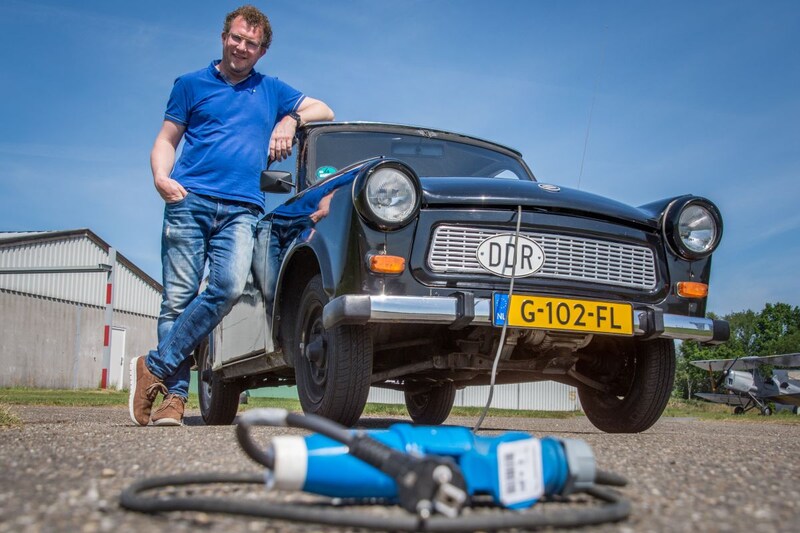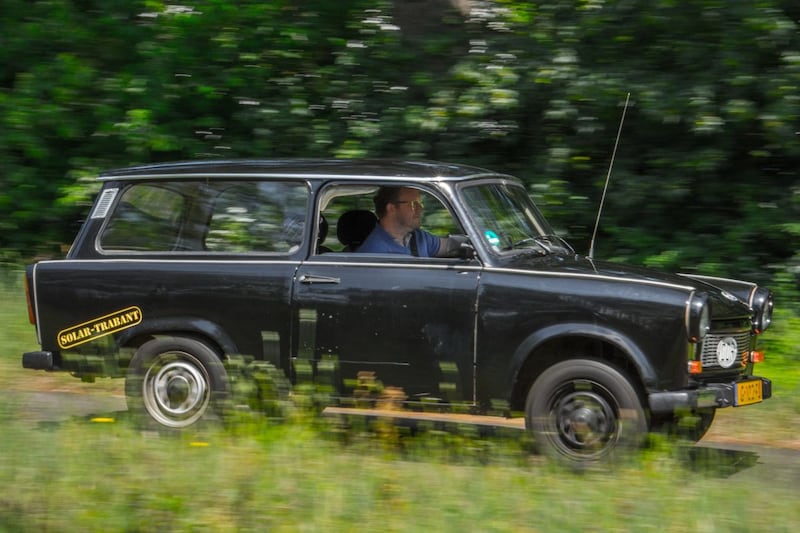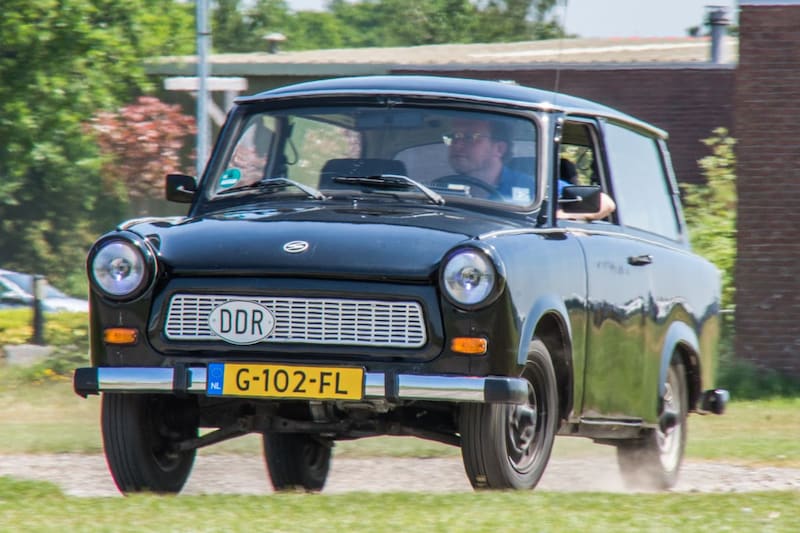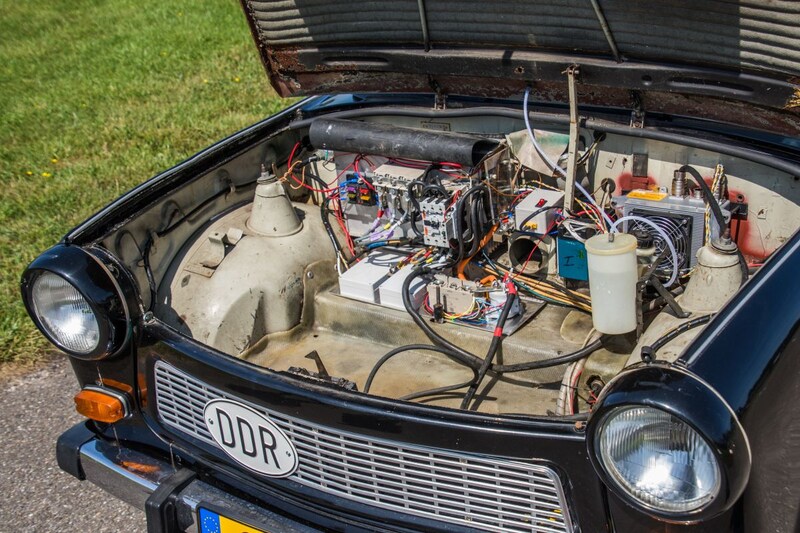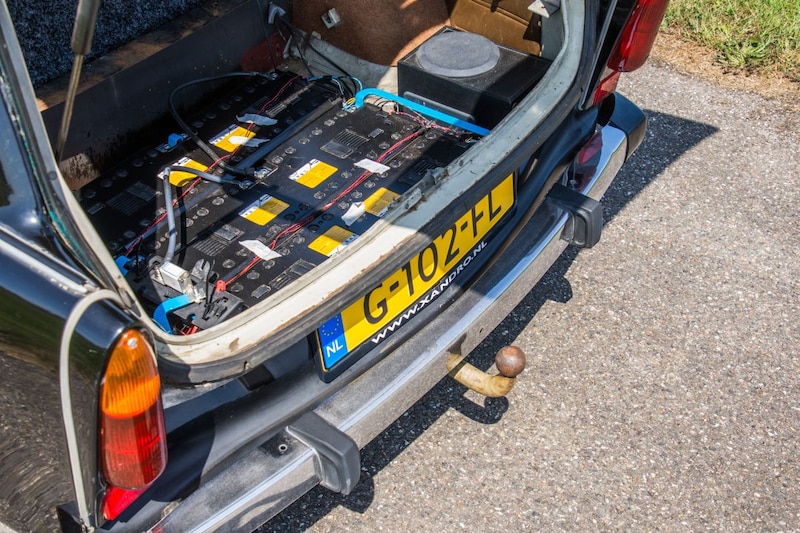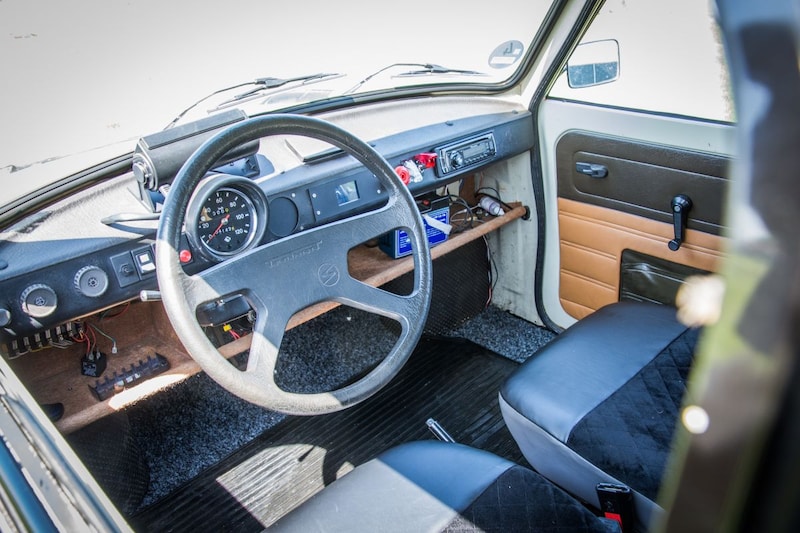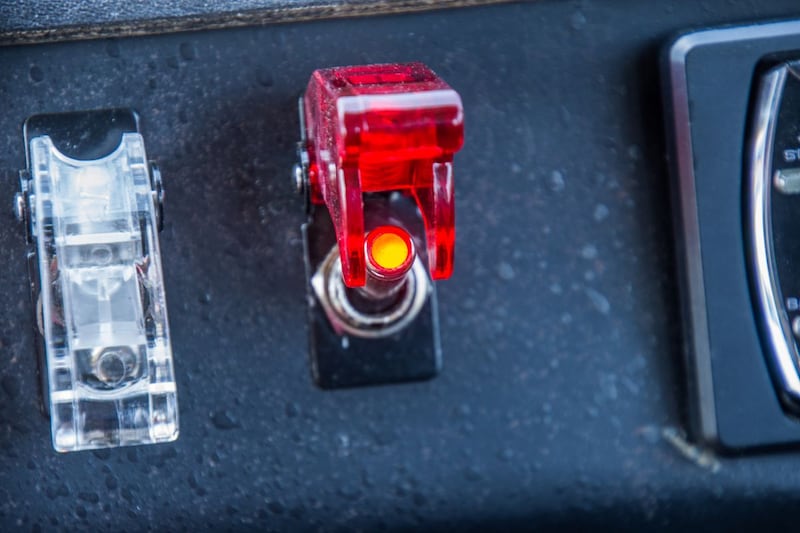Sander Drooglever drives a Trabant. You know, one of those simmering pots from the former East Germany. What if you take out that smelly motorbike? Without heart no soul. That raises the question of what remains of a Trabant if you strip it of its two-stroke engine, and with it its noise, the stench of oil and that huge cloud of blue smoke? An empty shell, you would think. But a total champion? Or a true sun king? Nobody thinks that possible. Yet it is so.
The Trabant needs no introduction. The GDR’s smokey, smoldering and eardrum-destroying symbol was a dramatically bad car, but it made a nation mobile. Thirty years after the fall of the wall, the whole world is Im Herzen. Trabant owner Sander Drooglever from Hoogeveen can tell you wonderfully about this. More on that later, first we have to go back to Germany. There lives someone who can explain better than anyone why Sanders Trabant is unique and progressive. In fact, he unmasks the ultramodern, iPad-like and super environmentally friendly Teslas that the whole world in 2021 is running away with for the boring latecomers that they are. One electric Trabant has more character than all Dutch EV drivers have ever saved on addition.
Club of Rome
Wait, electric Trabant? “Yes,” says Michael Trykowski. He doesn’t say that lightly. Trykowski is a two-time world champion and also entered the Guinness Book of Records. Although he did not do this with Trabant, he did use solar energy. “As a student I already tinkered with cars. First out of lack of money, but later also because I liked it,” he says. In 1973, while studying architecture, he read the report ‘Limits to growth’ of the Club of Rome, which fascinated him so much that a lifelong fascination with the theme of ‘energy’ was born. Solar energy in particular fascinated Trykowski immensely. In his work he could hardly do anything with his fascination, because in the mid-1970s solar energy in homes was at most a miniscule niche. In 1984, Swiss solar pioneer Josef Jenni devised the Tour de Sol, a ride for solar-powered cars designed to form a sort of moving advertising caravan. Trykowski decided to build a vehicle together with a group of German enthusiasts and participate in the Tour de Sol. “In theory we knew a lot”, the German laughs, “but yes, in practice, huh? We learned a lot of important lessons in that first Tour de Sol. The fact that the fuel gauge on a solar-powered car decreases when you’re standing still, for example, I found unique. And that solar-powered cars are very quiet. Even before the start I had a cyclist on the hood. The most important lesson is that efficiency is important, solar energy has no mercy in that. Our first vehicle had a lot of weaknesses, I ended up having to push it myself. That hurt my ego, but it did push me to do better.” The rest is history. Trykowski would win the Tour de Sol – and with it the solar world championship – twice.
Apple and an egg
But how does a solar-powered world champion manage to convert a Trabant into a solar vehicle? “Simple”, says Trykowski, “a solar-powered car is electrically powered, and I found it interesting to investigate how you could make an electric car suitable for everyday use. The Trabant was an ideal platform for this. Not only because it weighs only 450 kilograms without a tank, engine and drivetrain, but also because masses of East Germans wanted to exchange their Trabant for something western after the fall of the wall. Trabants were therefore for sale for an apple and an egg. Moreover, it was a shame, also for the environment, to demolish them.” Trykowski’s experiment was not without result. “We built a powerful asynchronous motor that, with a consumption of 8 to 10 kWh per 100 kilometres, is still very efficient by today’s standards, because current EVs need 16 to 25 kWh to travel 100 kilometres. Unfortunately we were working with old leaded batteries. With modern batteries, our Trabant could have had a range of at least 300 kilometers.” The story of Trykowski’s Solar Trabi told itself: at the request of customers, he built thirteen electric Trabants, two of which were even fitted with a roof with solar panels. One of these was given a major role in the ZDF Siebenbirken series.
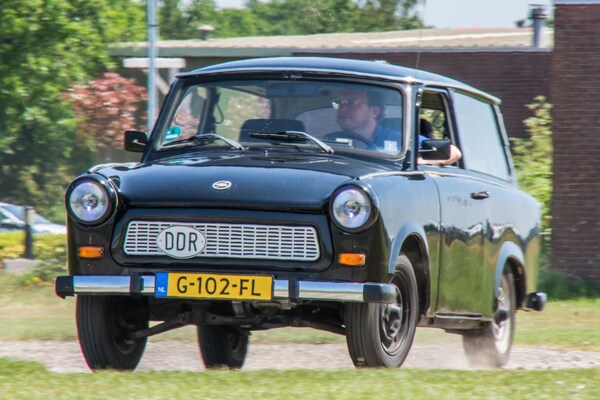
inveterate lover
Another Solar Trabi ended up in Hoogeveen. To be precise with Sander Drooglever. That was no coincidence, because Sander is an inveterate enthusiast of electrical engineering. He was looking for an electric car for the trips in the area, but it shouldn’t cost too much. What do you think? “A lot of ugly,” says Sander. By this he means an electric Saxo. Or a Peugeot Partner. Fun to tinker with, but it won’t really make you happy. De Drent only became happy when, to his own astonishment, he saw a Trabant for sale that left the factory in Zwickau in 1989 and was converted into Solar Trabi in 1991 by Michael Trykowski. “I like old stuff!”, he beams, “a Trabant is beautiful in its simplicity. How incredibly cool is it that it is also electric.” Sander went to Germany almost without thinking and picked up the electric Trabant. This made him the owner of the hobby project of his dreams. “For a pittance, that too.”
Star-triangle principle
Sander is a busy bee who – like Michael Trykowski – has a fascination for electrical engineering and likes to tinker with it. The fact that he received a huge stack of manuals with his Solar Trabi that explain the electrical construction of the Trabant made him particularly happy. He learned that his Solar Trabi contains thirteen old lead-acid batteries in a refrigerator size, five of which he managed to get himself from the old iron farmer. A broken pulse generator ensured that poor Trabant reached 1 kilometer per hour upon his arrival in the Netherlands. Sander was able to repair that defect, so that he could bring the Trabant to the RDW for a Dutch license plate. The judges loved it, Sander too. Not that the Trabant could zoom down the road without any worries, but Sander doesn’t mind that. “The motor works on the star-delta principle, but got stuck in the start-up position. He actually walked on one leg. That was only solved after I had disconnected everything and reconnected it as it should be according to the drawing.
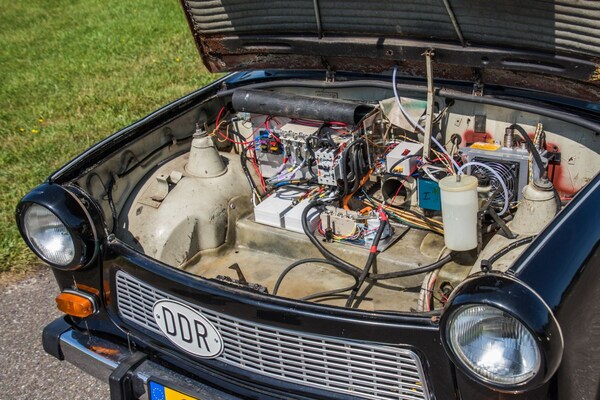
I am now also in contact with Michael Trykowski. If I really can’t figure it out, he will help me with advice and assistance. And I have an alternative: if it doesn’t work out, I’ll build in the engine from a Think City. It is much stronger, so I have a fast Trabant!” Speed demands safety, so Sander built in a voltage interrupter so that the Trabi is not continuously under voltage. “Very safe, should something happen.” Speaking of safety: in that context, Sander also placed LED headlights in his Trabi. “Driving in the dark was impossible”, he says, “halogen light drained my 12-volt battery in no time. I already need 12 volts for the relay that powers the car, so the lighting now works on a separate battery.” Meanwhile, Sander also plans to increase the range by placing the battery pack of a Mitsubishi Outlander under the hood of his Trabant. “There are still six batteries that fit. The Outlander has LEV40 cells, so in total I could get to 190 volts. But yes, it will be very heavy. But I have plenty of plans. I don’t like to sit still,” he laughs apologetically. Sander likes to learn new things: gliding for example. He is also very fanatical about this. “But the Trabant is also instructive, I think it’s wonderful to see how such an electric car works.”
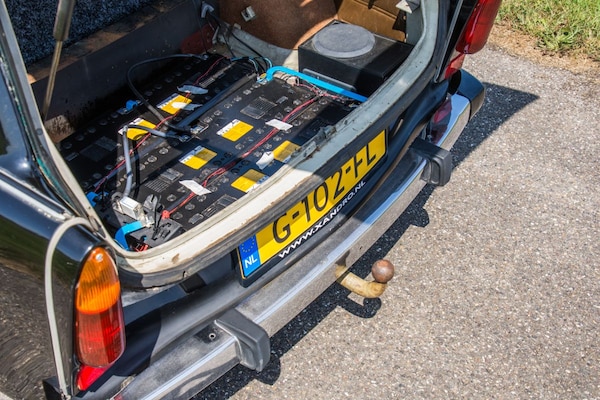
Around the IJsselmeer?
Sander does not have to sit still anyway, because although it is sometimes difficult, he likes to go out for a ride with his Solar Trabi. “Although that typical two-stroke noise is great, I don’t miss it,” he says. “I’m not much for grease and grease. I like an old electric motor much more, and my Trabant is incredibly quiet. So quiet that you take the rattling of the carriage for granted. The odometer is not quite right, but I’m guessing the range is now about 40 kilometers, and with the current voltage I get about 60 kilometers per hour.” He says that he simply charges at home, in the socket. “That takes two hours at most and costs nothing at all, so you laugh to death.” The range could be a bit larger in his opinion. So there is still some work for him to do. “My goal is secretly to do a round of the IJsselmeer. I just don’t like the Afsluitdijk, because what if it empties there? And I don’t even dare to drive on the highway. But what does it matter. The best part is that everyone greets you when you drive by, and then they look for a cloud of blue smoke that isn’t there. When I explain that this is an electric Trabant, people think I’m crazy. I love that. A car has to be a little crazy, and this one gets everyone laughing. Then it doesn’t matter anymore whether I complete that round of the IJsselmeer!”
Also a champion?
A round of the IJsselmeer doesn’t add much to the resume of a car that was created by a world champion, Sander also realizes. Michael Trykowski used the most obsolete car he could buy to create an EV that was way ahead of its time. But while the history books will always recognize him as the solar world champion, Michael Trykowksi didn’t achieve eternal fame as the progenitor of the modern EV. “At the time, manufacturers such as Honda, General Motors and Ford were already exploring the possibilities of electric propulsion, but German brands were not interested. It became more and more expensive for me to continue my activities independently, so I stopped building electric cars in 1992. But that doesn’t mean the effort was in vain. What I learned on the road about efficiency I could put to good use in my work as an architect. Since then I have been able to realize a huge number of energy-efficient homes. So it was definitely good for something.”
Anyone who encounters a whisper-quiet Trabant around Hoogeveen knows that he moves in higher circles. The Trabant is a sun king, its maker a true champion. And Sander? He deserves recognition because he managed to save a unique car from oblivion. He had a stainless steel nameplate made especially for his Solar Trabi, in the style of the House of Zwickau. “Electrabant,” it says. If you give your Trabant such a beautiful gift, aren’t you also a champion?
– Thanks for information from Autoweek.nl
